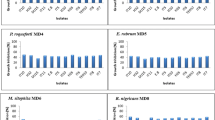Abstract
The antifungal activities of 85 lactic acid bacteria strains isolated from fermented wax gourd against the four fungal species, Penicillium oxalicum, Aspergillus flavus, Aspergillus sydowii, and Mucor racemosus, were determined. Inhibitory activity against at least one or more fungal species was observed with 27 Weissella cibaria and 11 Weissella paramesenteroides strains. Among these strains, W. cibaria 861006 and W. paramesenteroides 860509 showed greater inhibitory activities and were therefore selected for further analysis. The results suggested that the antifungal activities were originated from the organic acids produced by W. cibaria 861006 and W. paramesenteroides 860509. The application tests indicated that the growth of P. oxalicum could be effectively inhibited by W. cibaria 861006 for 6 days on grape surfaces. However, W. paramesenteroides 860509 could only remain its inhibition effect for 48 h. The findings obtained in this study suggest the potential use of W. cibaria 861006 as a bio-protective agent against fungi for agricultural purposes or ready-to-eat fresh fruit and vegetable products.



Similar content being viewed by others
References
Askun T (2006) Investigation of fungal species diversity of maize kernels. J Biol Sci 6:275–281
Fustier P, Lafond A, Champagne CP, Lamarche F (1998) Effect of inoculation techniques and relative humidity on the growth of molds on the surfaces of yellow layer cakes. Appl Environ Microbiol 64:192–196
Gourama H (1997) Inhibition of growth and mycotoxin production of Penicillium by Lactobacillus species. Lebensm Wiss Technol 30:279–283
Katsumata R, Kumagai Y, Takeuchi S, Muramatsu K, Kikoku Y, Kiuchi K (2002) Inhibition of the growth of Aspergillus flavus with spice essential oils and their components added to strawberry jam. J Antibact Antifung Agents 30:197–206
Kwon JH, Shen SS, Jee HJ (2008) Occurrence of blue mold on tomato caused by Penicillium oxalicum in Korea. Plant Pathol J 24:87–89
Lan WT, Chen YS, Yanagida F (2009) Isolation and characterization of lactic acid bacteria from Yan-dong-gua (fermented wax gourd), a traditional fermented food in Taiwan. J Biosci Bioeng 108:484–487
Lavermicocca P, Valerio F, Visconti A (2003) Antifungal activity of phenyllactic acid against molds isolated from bakery products. Appl Environ Microbiol 69:634–640
Matamoros S, Pilet MF, Gigout F, Prévost H, Leroi F (2009) Selection and evaluation of seafood-borne psychrotrophic lactic acid bacteria as inhibitors of pathogenic and spoilage bacteria. Food Microbiol 26:238–244
Pitt JI, Hocking AD (1997) Fungi and food spoilage, 2nd edn. Blackie Academic and Professional, London, p 596
Rouse S, van Sinderen D (2008) Bioprotective potential of lactic acid bacteria in malting and brewing. J Food Protect 71:1724–1733
Rouse S, Harnett D, Vaughan A, van Sinderen D (2008) Lactic acid bacteria with potential to eliminate fungal spoilage in foods. J Appl Microbiol 104:915–923
Sathe SJ, Nawani NN, Dhakephalkar PK, Kapadnis BP (2007) Antifungal lactic acid bacteria with potential to prolong shelf-life of fresh vegetables. J Appl Microbiol 103:2622–2628
Sjögren J, Magnusson J, Broberg A, Schnürer J, Kenne L (2003) Antifungal 3-hydroxy fatty acids from Lactobacillus plantarum MiLAB 14. Appl Environ Microbiol 69:7554–7557
Ström K, Sjögren J, Broberg A, Schnürer J (2002) Lactobacillus plantarum MiLAB 393 produces the antifungal cyclic dipeptides cyclo(L-Phe-L-Pro) and cyclo(L-Phe-trans-4-OH-L-Pro) and 3-phenyllactic acid. Appl Environ Microbiol 68:4322–4327
Trias R, Bañeras L, Montesinos E, Badosa E (2008) Lactic acid bacteria from fresh fruit and vegetables as biocontrol agents of phytopathogenic bacteria and fungi. Int Microbiol 11:231–236
Umemoto S, Odake Y, Takeuchi T, Yoshida S, Tsushima S, Koitabashi M (2009) Blue mold of tomato caused by Penicillium oxalicum in Japan. J Gen Plant Pathol 75:399–400
Yanagida F, Chen YS, Onda T, Shinohara T (2005) Durancin L28-1A, a new bacteriocin from Enterococcus durans L28-1, isolated from soil. Lett Appl Microbiol 40:430–435
Acknowledgments
The authors would like to thank Mr. Chi-huan Chang for his kind cooperation in sampling and for technical assistance.
Author information
Authors and Affiliations
Corresponding author
Additional information
Wei-tse Lan and Yi-sheng Chen contributed equally to this work.
Rights and permissions
About this article
Cite this article
Lan, Wt., Chen, Ys., Wu, Hc. et al. Bio-protective potential of lactic acid bacteria isolated from fermented wax gourd. Folia Microbiol 57, 99–105 (2012). https://doi.org/10.1007/s12223-012-0101-1
Received:
Accepted:
Published:
Issue Date:
DOI: https://doi.org/10.1007/s12223-012-0101-1




